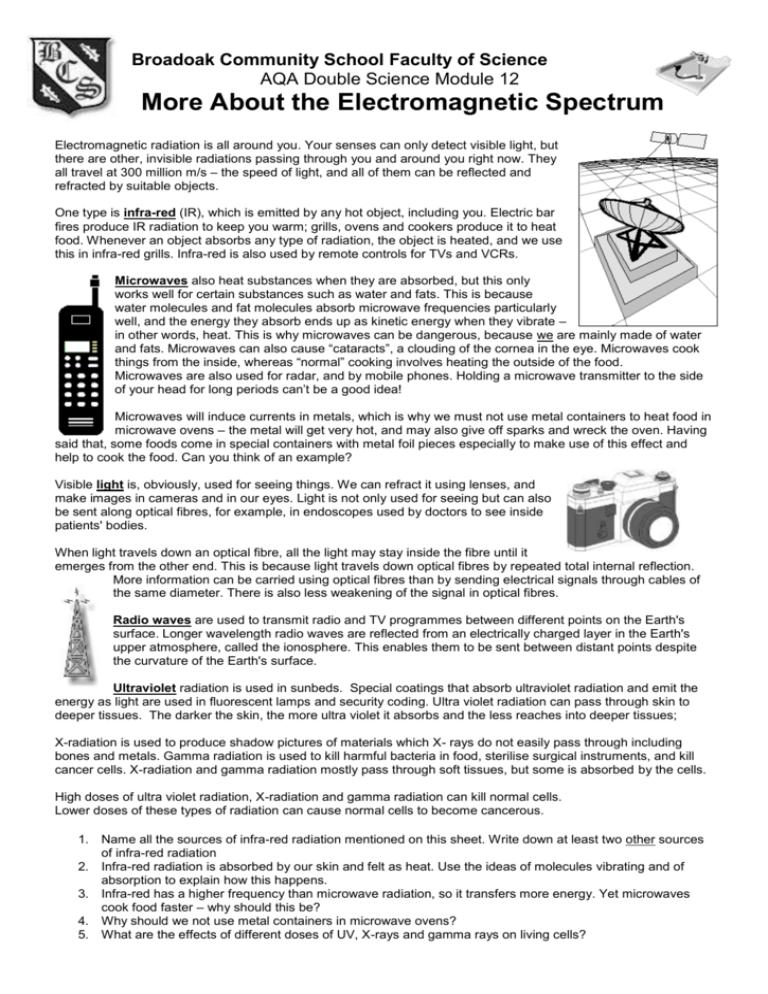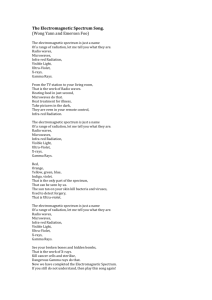about the EM spectrum
advertisement

Broadoak Community School Faculty of Science AQA Double Science Module 12 More About the Electromagnetic Spectrum Electromagnetic radiation is all around you. Your senses can only detect visible light, but there are other, invisible radiations passing through you and around you right now. They all travel at 300 million m/s – the speed of light, and all of them can be reflected and refracted by suitable objects. One type is infra-red (IR), which is emitted by any hot object, including you. Electric bar fires produce IR radiation to keep you warm; grills, ovens and cookers produce it to heat food. Whenever an object absorbs any type of radiation, the object is heated, and we use this in infra-red grills. Infra-red is also used by remote controls for TVs and VCRs. Microwaves also heat substances when they are absorbed, but this only works well for certain substances such as water and fats. This is because water molecules and fat molecules absorb microwave frequencies particularly well, and the energy they absorb ends up as kinetic energy when they vibrate – in other words, heat. This is why microwaves can be dangerous, because we are mainly made of water and fats. Microwaves can also cause “cataracts”, a clouding of the cornea in the eye. Microwaves cook things from the inside, whereas “normal” cooking involves heating the outside of the food. Microwaves are also used for radar, and by mobile phones. Holding a microwave transmitter to the side of your head for long periods can’t be a good idea! Microwaves will induce currents in metals, which is why we must not use metal containers to heat food in microwave ovens – the metal will get very hot, and may also give off sparks and wreck the oven. Having said that, some foods come in special containers with metal foil pieces especially to make use of this effect and help to cook the food. Can you think of an example? Visible light is, obviously, used for seeing things. We can refract it using lenses, and make images in cameras and in our eyes. Light is not only used for seeing but can also be sent along optical fibres, for example, in endoscopes used by doctors to see inside patients' bodies. When light travels down an optical fibre, all the light may stay inside the fibre until it emerges from the other end. This is because light travels down optical fibres by repeated total internal reflection. More information can be carried using optical fibres than by sending electrical signals through cables of the same diameter. There is also less weakening of the signal in optical fibres. Radio waves are used to transmit radio and TV programmes between different points on the Earth's surface. Longer wavelength radio waves are reflected from an electrically charged layer in the Earth's upper atmosphere, called the ionosphere. This enables them to be sent between distant points despite the curvature of the Earth's surface. Ultraviolet radiation is used in sunbeds. Special coatings that absorb ultraviolet radiation and emit the energy as light are used in fluorescent lamps and security coding. Ultra violet radiation can pass through skin to deeper tissues. The darker the skin, the more ultra violet it absorbs and the less reaches into deeper tissues; X-radiation is used to produce shadow pictures of materials which X- rays do not easily pass through including bones and metals. Gamma radiation is used to kill harmful bacteria in food, sterilise surgical instruments, and kill cancer cells. X-radiation and gamma radiation mostly pass through soft tissues, but some is absorbed by the cells. High doses of ultra violet radiation, X-radiation and gamma radiation can kill normal cells. Lower doses of these types of radiation can cause normal cells to become cancerous. 1. Name all the sources of infra-red radiation mentioned on this sheet. Write down at least two other sources of infra-red radiation 2. Infra-red radiation is absorbed by our skin and felt as heat. Use the ideas of molecules vibrating and of absorption to explain how this happens. 3. Infra-red has a higher frequency than microwave radiation, so it transfers more energy. Yet microwaves cook food faster – why should this be? 4. Why should we not use metal containers in microwave ovens? 5. What are the effects of different doses of UV, X-rays and gamma rays on living cells?






